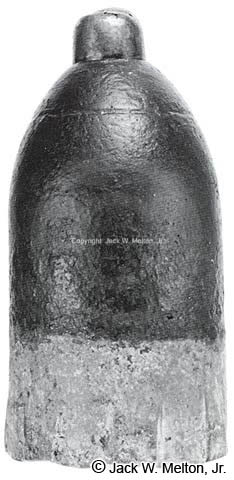Great Britain
Britten
DIAMETER: 3.44 inches
GUN: 12-pounder Blakely rifle, 3.5-inch caliber
LENGTH: 7 1/4 inches
WEIGHT: 12 pounds 2 ounces
CONSTRUCTION: Shell, segmented interior
SABOT: Lead cup
FUZING:
Britten percussion

The interior has nine long wedges of iron with lines of weakness cast in each wedge. Ideally, the bursting charge broke the 9 long wedges into fifty-four fragments, and the outer shell body into many fragments as well. Note the Britten percussion fuze with its distinctive brass anvil cap. The Britten percussion fuzes have a left hand thread pattern.
Examples have been recovered from Spanish Fort, Alabama, and the Battle of Seven Pines, Virginia.